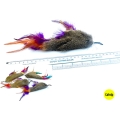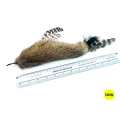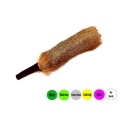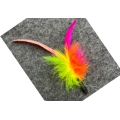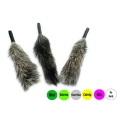How to Play with your Cat
The Importance of Play
Why Play?
Play is an essential activity for cats of all ages, young and old. Not only does play encourage bonding between you and you cat, it is also fun and mentally stimulating for your feline friend. Additionally, play prevents boredom, reduces anxiety, and is a great form of exercise. Cats are athletic creatures with incredible stamina, both mental and physical; play gives them an outlet for this energy, and gives them an opportunity to satisfy their innate hunting drive. All this makes for a happy and healthy cat!
What to play with?
All cats should have a selection of toys, to cover all of their instinctive needs, such as, toys for chasing, toys for batting around, toys to hide inside, and toys for hunting. Some cats prefer ground hunting, while others prefer more aerial pursuits. Despite many owners providing lots of toys for their cats, these are often tucked away in a toy box, so to your cat, these toys are essentially dead prey, e.g. they don’t move. This is boring to cats, and often will not stimulate a play session. Some of the most enjoyable toys for cats are “Interactive” ones, which will usually stimulate the most intense (and satisfying!) play sessions.
What is Interactive Play?
Interactive play helps strengthen the bond between you and your cat by letting you share fun and positive experiences. The concept is simple – Interactive Play involves YOU! Interactive play is a very powerful tool, and if used correctly, the play can be great for trust building, exercise and stress relief for your cat.
This is achieved by using toys that can float, twirl, dart and fly in ways that simulate live prey. For example, you can use the Amazing PurrSuit Wand with an attachment of your choice, to create prey-like action, which will allow you cat to act like the athletic hunter that she was meant to be. With the Purrsuit Interchangeable Wand, you can put life into the toy, so that the target at the end of the string can wiggle, creep, fly or dart around the room, or garden. Your cat’s speed and grace will amaze you as she dashes around trying to capture the prey.
Tips to get your cat motivated!
1) Make the movement of the toys resemble prey:
How you move the interactive toy is important. Don’t wave it around frantically in order to give your cat exercise, that’s not the way cats hunt. The toys need to be moved in a way that will trigger your cat’s prey drive. One thing to remember here is that prey (e.g. rodents, birds) would not be running around (or flying) directly in front of the cat. Start by subtly quivering the toy in order to get your cats attention. Don’t keep the toy in a constant motion. Then, start to move the toy like prey by alternating between fast and slow motions; this will give your cat the time to plan the next move.
2) Don’t touch your cat with the toy:
The toy is supposed to be simulating a ‘real’ rodent or bird, etc, and therefore it would be very unlikely ‘in the real world’ that a rodent, or any other type of prey, would actually walk up to the cat!
To stimulate your cat and to get it entranced, move the toy away from them! Cats hunt by watching, hiding, stalking, waiting, and then finally pouncing on its prey. To stimulate your cat into play mode, move the wand and attachment away from the cat. Then stop the toy moving, and hold it still for a couple of seconds, and then make it quiver. You can then hide the toy behind furniture. Continue to do this until your cat stalks, follows and eventually pounces on the toy.
3) Allow your cat to taste success:
Your cat needs to have several ‘captures’ of the toy, so that they don’t get frustrated. So, allow your cat to swat the toy with it’s paw, and then allow your cat to pounce on the toy, as it would do in the wild. These ‘victories’ will serve to build your cats confidence. However, don’t make it too much of a challenge for your cat to successfully grab the toy in it’s mouth or paws – this will only end up frustrating your cat. If the cat starts to walk away with the toy and won’t let it go, give the toy some slack and let the cat enjoy the capture for a short time. Alternatively, you could give your cat a reward toy (e.g., Purr Purrizes Toy), in order for it to release the interactive toy. Remember… the game needs to be fun for your cat.
4) Always end the play session on a positive note:
When you want the game to end, slowly wind down the movements of the toy, as if the prey is getting tired. As the toy get slower (and eventually ‘dies’ in your cats eyes), your cat will start to relax thinking that she has accomplished a grand capture! Let your cat experience the thrill of victory – it will make them want to play again, another day.
It’s a good idea to end the play session by giving your cat a few tasty treats; this is what would happen in the wild ……. they would stalk, chase, ambush, kill and then eat their prey! By giving your cat a tasty morsel at the end of the game will not only signify the end of the play session, but will also help your cat to feel accomplished.
Finally!
Maintain a regular schedule of interactive play, so that your cat has consistency. As guideline, schedule playtime for once or twice a day for about 10-15 minutes per session.
You will be amazed at what a 15-minute interactive play session can do for your cat’s physical and emotional health!
NB: All the interactive toys should be put away and out of the cats reach when the play sessions are over. This is to protect your cat from injury and to make sure that the toys keep their strong appeal.
Kindly provided by
Kim Houston BSc (Hons), Dip (AS) CABC, CCAB
Certified Clinical Animal Behaviourist https://cat-astrophes.com/
TOP TIP
Top Tip from Jackson Galaxy if your cat won't let go of the wand hunt prey toys and how to stop them eating toy prey https://youtu.be/NYKQiu71tZM






